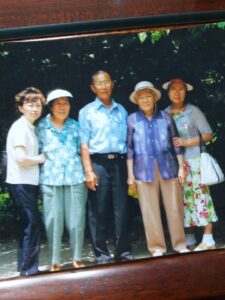
Kim Byeong-nyeo, my great-aunt, the seed of inspiration for 8 Lives of a Century-Old Trickster, passed away this summer, while I was working on the last chapter of the novel. She was ninety-three years old, and it was a quiet death. Her funeral was also a quiet event, due to both the COVID-19 pandemic and her complicated family history. There were only three attendees at the funeral: a social worker from the public nursing home where she had drawn her last breath, a representative from the association of North Korean defectors in South Korea, and my father, her younger sister’s son. She had no immediate family members alive in South Korea.
My great-aunt was the strangest person I’ve ever met.
She was a true hybrid or an unflinching turncoat: she was born Japanese; lived as a North Korean; and yet died as a South Korean.
She was born and spent her childhood in Korea under the Japanese occupation. Then, separated from her siblings by the Korean War, she spent her youth and midlife in Pyongyang as a wife and a mother. In her sixties, however, she made in secret a dramatic decision to escape alone from North Korea, leaving her family in the dark. She spent the following decade in China, and finally arrived in South Korea by herself in her seventies.
When I met her and asked her why she had decided to defect, her answer was as vague and hopeful as that of South Korean college students who travel overseas: I wanted to see the bigger world. What I wanted the most to hear about, however, was her life in North Korea, the most secluded nation in the world. While she was eager to talk about her flamboyant living in China as an herbal doctor and a fortune-teller, she was always reluctant to tell her story of Pyongyang, probably due to the obsessive fear that revealing details of her totalitarian fatherland might expose her children in North Korea to further danger.
When I started entertaining the idea of writing about her life, however, I learned that her version of the story would be lost in mystery forever: while I was studying in America, she developed Alzheimer’s, and quite quickly her memory began to fail. When I went to see her in a public nursing home in the countryside in 2010 she didn’t recognize me at all. Although her sharp wit and knowledge of Chinese and Japanese were still mostly there, she seemed unable to carry a coherent conversation on a single subject for more than ten minutes.
My novel, 8 Lives of a Century-Old Trickster, slowly came into being from there—the void of firsthand narrative from a real person, who is the seed of inspiration for the book. Little by little, sporadically over the period of a decade, I’ve been filling the void with my own imagination and desire, creating a whole different animal of a story. Even though I consulted numerous nonfiction books and testimonies of North Korean defectors and war survivors to give the novel a sense of reality, 8 Lives of a Century-Old Trickster isn’t at all tethered to or limited by historical verifiability.
The peculiarity of my great-aunt’s character and her life choices are what sparked this book into life. And to stay true to these turbulent characteristics of her life, I stayed away from the conventional narrative structure where everything flows in a perfectly streamlined arc. Chapters of 8 Lives of a Century-old Trickster are tricksters in their own way: they unfold in nonchronological order; they often shift from one point of view to another; and while in its entirety the novel surrounds the life of one woman, each chapter works as a story of its own, a standalone narrative.
8 Lives of a Century-Old Trickster is a hybrid in its approach to genre as well. The chapters shift in terms of their tones and moods to capture the manifold experiences of the main character in different moments of her life. Kim Byeong-nyeo lived through the most tumultuous period of Korean history, witnessing the Japanese occupation, the Second World War, the Korean War, and the Cold War among others. Such an eventful life, in line with the varying moments of its course, requires wearing masks of different genres: horror, thriller, dystopia, dark comedy, bildungsroman, and even love story.
Kim Jung-hyuk, a South Korean fiction writer, once said “I am closer to discontinuous being than to continuous one.” Kim Jung-hyuk often turned to his old diaries for artistic inspiration, and as he read through the varying thoughts of his younger selves in different time periods, he wondered if he could truly say those personae were the same man as he had become. His own answer for the question was no; he found Kim at sixteen so foreign to Kim of age for starters. He realized the reason why he could always use his old diaries as new writing material was because they were as good as the words of strangers. Charlie Chaplin said, “Life is a tragedy when seen in closeup but a comedy in long-shot,” but I came to believe that the scope of most human lives goes much further than the binary choice between closeup and long-shot. Life shows a collection of diverse personae from distinctive experiences rather than a single entity with a unified backstory. And that’s why my protagonist Trickster has eight lives instead of one. Depending on the segment of her life in closeup, you may see a slave, an escape artist, a murderer, a terrorist, a spy, a lover, or a mother.
